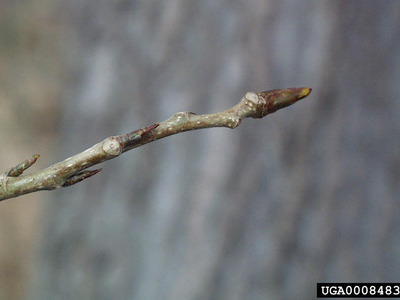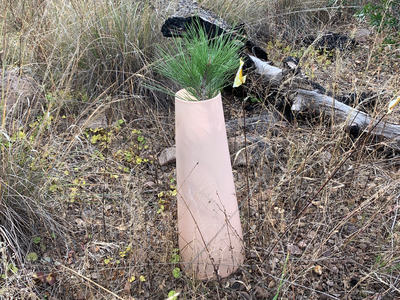Reforesting with live stakes
One of the simplest and most effective methods for restoring riparian woodlands is the use of live stakes, also known as cuttings. Live staking involves placing cut tree stems and branches directly into the ground, where they can develop roots and establish as new plants. Live staking of trees mimics one of the natural ways some species regenerate, as living material from plants located along waterways are washed downstream and establish in newly deposited soils.
Live stakes for a riparian buffer
The riparian zone is the area around a body of water (such as a creek, bayou, or other type of stream) that serves as a transition zone between water and the dry upland area from which the water rains. Riparian forests improve the infiltration of water into soil, which reduces runoff from storm flows and filters pollutants. Riparian forests also reduce the erosion of soil particles during high flow events and provide valuable habitat for wildlife.
At least 50 feet of buffer width is required on each side of the streambank to effectively mitigate stormwater and reduce erosion potential. Steep sites may require wider forest buffers to stabilize highly erodible soils.
Plant live stakes in areas that are routinely saturated, but not tidally influenced or prone to significant flooding which may cause stakes to uproot and wash away.
Species selection
All trees originate from seeds, but some species may be easier to grow using other regeneration methods. Some species, like many in the willow family (Salicaceae, which includes willows; Salix spp., and cottonwoods; Populus spp.) will generate more successfully via cuttings than by seeds.
Below highlights a sample of riparian species suitable for live stakes and identifies additional regeneration methods effective for those species. This list is not exhaustive. Our foresters can provide you with more information on regenerating other species.
| Species | Wetland indicator* | Planting method | Location in Texas |
|---|---|---|---|
| River birch (Betula nigra) | FACW |
|
|
| Buttonbush (Cephalanthus occidentalis) | OBL |
|
All regions in Texas |
| Desert willow (Chilopsis linearis) | FACU |
|
|
| Roughleaf dogwood (Cornus drummondii) | FAC |
|
|
| American sycamore (Platanus occidentalis) | FAC |
|
|
| Eastern cottonwood (Populus deltoides) | FAC |
|
|
| Fremont cottonwood (Populus fremontii) | FAC |
|
|
| Black willow (Salix nigra) | FACW |
|
|
| Arroyo willow (Salix lasiolepis) | FACW |
|
|
*Wetland indicator categories:
- OBL – Obligate Wetland; these plants are only found in wet areas, never in dry locations.
- FACW – Facultative Wetland; these plants usually grow in wet and seasonally moist areas.
- FAC – Facultative; these plants can tolerate wet conditions as well as periodically dry conditions.
- FACU – Facultative Upland; these plants do not tolerate very wet conditions and are indicative of dry locations.
- UPL – Obligate Upland; these plants almost always occur in non-wet areas.
Sourcing live stakes

Willows (Salix) and cottonwoods (part of Populus), both in the willow family (Salicaceae), are common tree species in riparian forests, where they are some of the first trees to establish on newly deposited soils. During high flow events, lightweight branches break and are washed downstream, where they are deposited with sediment along streambanks and soon establish roots.
Willows and cottonwoods are fast growing and can reach sizes up to ten times that of other woody species that can be live staked, such as buttonbush (Cephalanthus occidentalis) and dogwoods (Cornus sp.). Making them excellent choices for establishing riparian buffers and stabilizing soils. With this in mind, much of the following planting information is centered around these species.
Many tree and native plant nurseries sell cuttings from late fall through the winter dormancy season. Suitable trees will be dormant. Leafless with visible buds along the entire length.
Live stakes can also be sourced locally from already established trees during the late fall or early winter. Inspect the tree before cutting to confirm that it is healthy and free of pests or disease. Select branches that are at least a ½ inch in diameter and two to three feet in length. Cut the end of the stake so that the end is angled. This will help when its time to push the stake into the ground.
Storing live stakes
Source your stakes as close to your planting date as possible, ideally planting them within 3-4 days from when they were cut.
Trim side branches from stakes before storing. Longer stakes can be cut into multiple sections. The top end of the stakes can be painted with a 50/50 mix of water and latex paint to help with distinguishing the ends when its time to plant.
Cuttings should be stored between harvesting and planting in a cool, moist place. Stakes can be stored in a five-gallon bucket with several inches of water during collection and staking. If stakes need to be stored for more than a day, seal them in a plastic bag. Do not overpack them, as some airflow is necessary to prevent mold or rot. Some sources recommend dipping the cut end of stakes into a low-concentration rooting hormone before planting, but this is not required.
Planting live stakes

Planting live stakes is relatively simple. Preferably, use a tool, like a piece of rebar, to create a pilot hole in the soil. Avoid pushing the stakes into the soil without a pilot hole, as this may damage the cutting.
With the angled-cut end of the stake facing towards the ground, push the stake into the soil perpendicular to the slope of the ground, leaving ¼ of the stake exposed aboveground. Very steep soils may require stakes to be angled more skyward so that the plant can properly grow. A mallet may be used to gently tap the stake into the ground. Make
a clean cut on the topside of the stake afterwards to remove any damage caused by the mallet.
Stakes can be planted in rows. Offset each row so that the stakes create a checkered pattern, which will optimize the planted area and better stabilize the stream bank.
Planting stakes every 15 feet provides 200 trees per acre (TPA), but higher planting densities may be more appropriate to achieve reforestation goals. For example, a denser planting with stakes every 6 feet results in roughly 1,200 TPA.
Planting live stakes can also use a range of planting densities to mimic natural ecosystems. For example, you may be plant with 30% of the area at high density and
60% at low density, with the remaining 10% left for grassland restoration. This creates a mixed selection of habitat for wildlife and native plant communities.
Planting density should also take into account the spacing requirements for mature trees and their large canopies and root systems. Small trees (20 ft tall or less at maturity) require a minimum planting area of 60 ft, medium trees (20-40 ft) require 120 ft, and large trees (taller than 40 ft) 180 ft. Trees of Texas can be used to find height projections for many common Texas tree species.
Live stakes can be planted anytime during the late winter while cuttings are dormant, though the exact planting window may vary by species. Willows prefer being staked between mid-fall and late winter, while cottonwoods have a wider staking window and can be planted through early spring.
Successful live stakes will devote energy during the first few growing seasons to producing roots. Meaning stakes may not produce many leaves during the first year after planting. During the spring and summer following staking, pull lightly on the stakes to feel if a root system has developed to determine if the stake is still alive.
After staking maintenance

Protective structures may need to be installed to protect established seedlings from herbivory by livestock, deer, feral hogs, and other wildlife. Follow the Temporary Browse Protection Guide for more information on constructing protective structures.
- Deer fencing: Constructing a physical barrier (fence) at least eight feet high can effectively keep deer away from young trees. Fencing can be made from wire mesh or electric fencing, which can also deter smaller mammals.
- Rodent barriers: For rabbits and small rodents, a wire mesh or hardware cloth around the base of young trees can prevent gnawing. A mesh diameter of one to two inches works well to keep smaller animals out.
- Tree guards: Commercially available plastic or mesh tree guards can be wrapped around the trunks of young trees to prevent rodents from chewing the bark. These are particularly useful for protecting trees from rabbits and squirrels. Wire mesh cages can also be wrapped around the tree and should be at least three feet in diameter and four feet tall. Tree guards should be removed after one to two years to prevent girdling.
Supplemental waterings at a rate of 8-10 gallons per week per stake can improve establishment and survival rates, though this may not be feasible for all sites and is optional. Water larger saplings six to eight gallons of water per diameter inch of trunk each week. For example, a 2-inch caliper sapling would require at least twelve gallons of water (2”x6 gal) each week. Avoid shallow waterings; thorough soakings encourage roots to spread away from the base of the tree, reducing opportunities for girdling and properly anchoring the tree.
Live stakes do not require supplemental fertilization during the first growing season. Too much nitrogen will burn the newly established roots, delaying establishment.
Live stakes likely will not need artificial supports. Inspect live stakes after wind or rain events to ensure stakes have remained upright. Avoid removing stakes from the ground to reposition them, as this may damage new roots. Stakes that become offset may self correct as the tree grows taller.